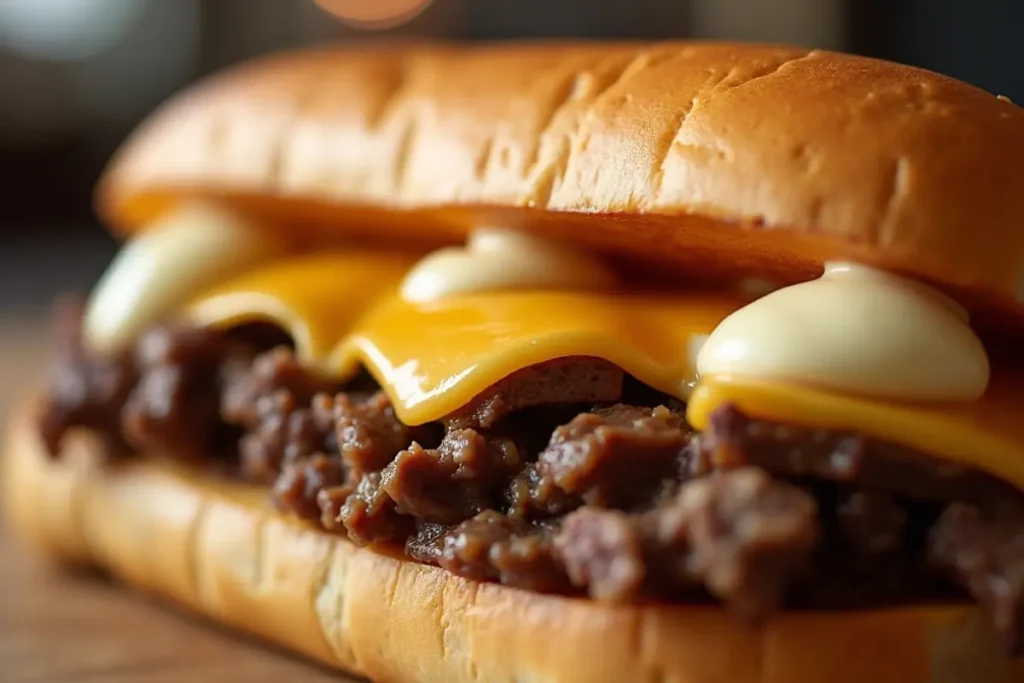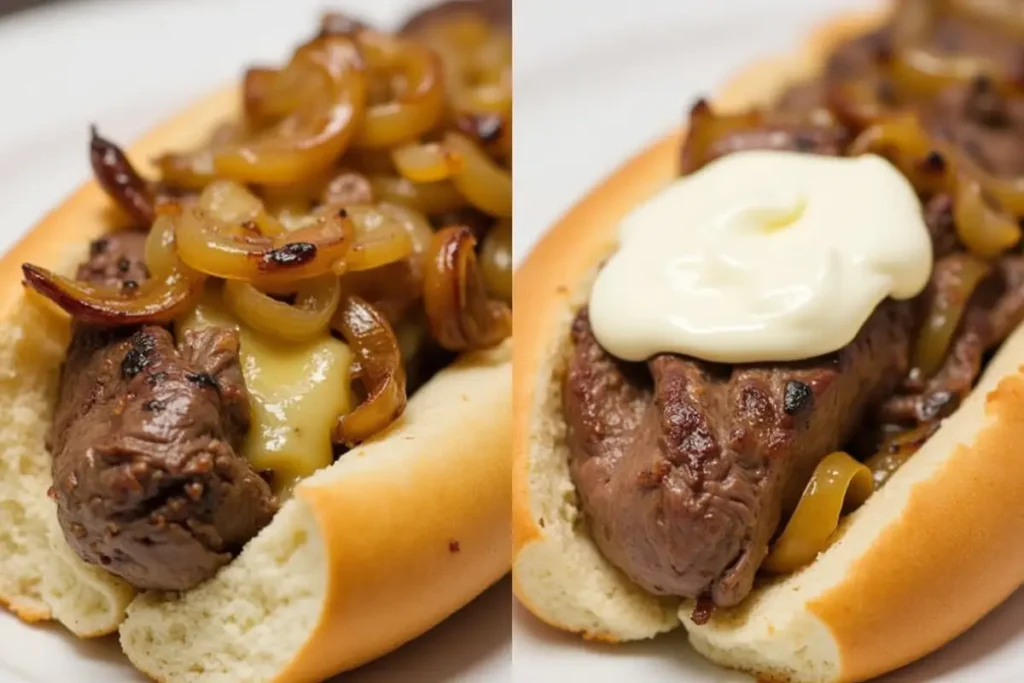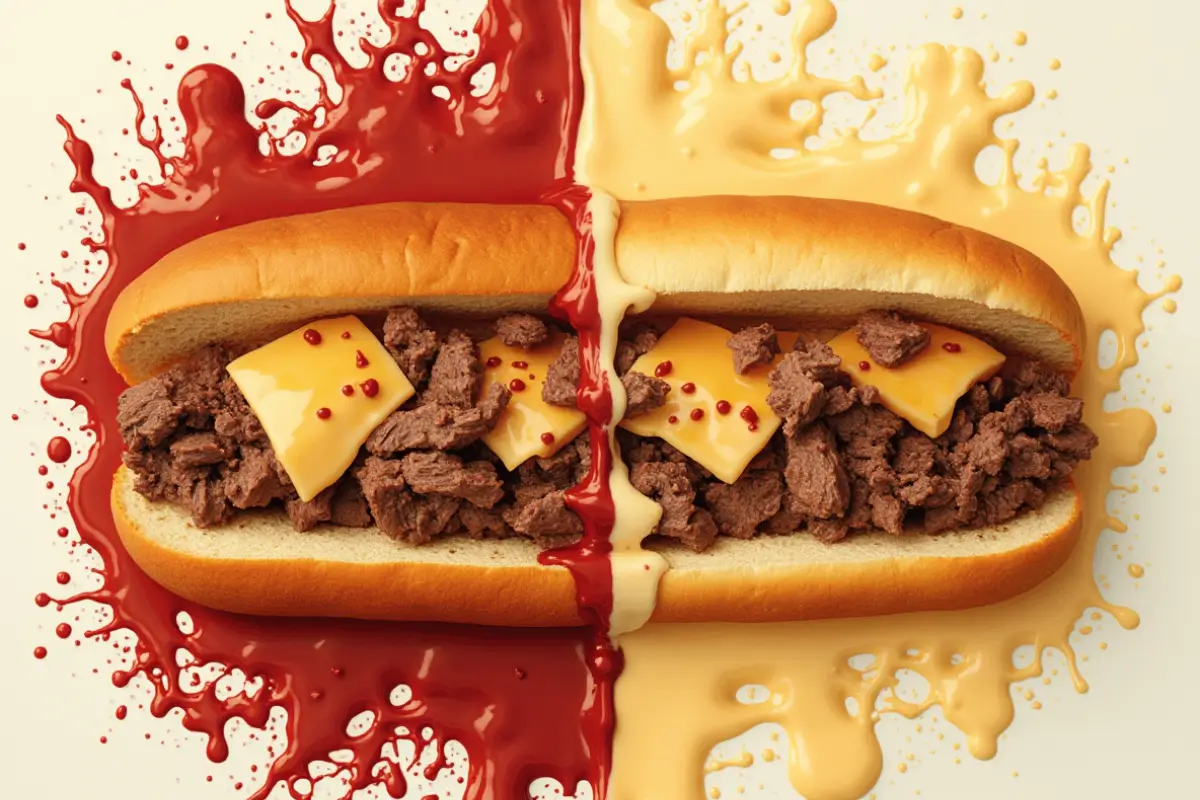Have you ever bitten into a sandwich that’s so perfect, so deeply rooted in culinary tradition, that you felt a jolt of pure satisfaction? That’s how you feel when you first encounter a truly great Philly cheesesteak. I remember my first one vividly – a hazy Philadelphia afternoon, the aroma of grilled onions hanging in the air, and the first, life-altering bite of that glorious combination of steak, cheese, and bread. It was, for me, a moment of delicious epiphany. However, even within this bastion of flavor, a storm brews – a controversy so heated it can divide families, shatter friendships, and fuel impassioned online debates: do you, or do you not, put mayo on a Philly cheesesteak?
The question isn’t simply about condiments; rather, it delves into the heart of culinary authenticity, personal preference, and regional pride. Some will argue with fervor that it’s an affront to tradition, while others will defend its creamy addition with equal gusto. So, where do you stand? Let’s explore this tasty predicament together, and by the end, you can decide what side you’re on.
The Classic Philly Cheesesteak: What’s Traditional?

Before we get bogged down in the great mayo debate, it’s crucial to understand what constitutes a truly authentic Philly cheesesteak. You see, it’s not just any steak sandwich. Instead, it’s a carefully constructed, symphonic blend of ingredients, each playing a crucial part in the final delicious masterpiece. This isn’t some generic steak and cheese – this is a culinary icon, carrying the weight of a city’s reputation.
The Essential Steak
The foundation of any true Philly cheesesteak begins with thinly sliced ribeye steak. It’s not pre-cooked; instead, chefs sizzle it on a hot griddle or flat-top, quickly developing a delicious crust while it remains juicy on the inside. The thin slices ensure that the meat cooks quickly and evenly, providing that tender, melt-in-your-mouth texture you would expect. The importance of the ribeye can’t be overstated—it’s the heart of the sandwich and the main source of that savory flavor.
The Cheese Selection
Then comes the cheese. Here, you have a choice, but these choices are not to be taken lightly. The traditional options often include provolone, Cheez Whiz, or American cheese, each offering a slightly different texture and taste. Provolone brings a mild, slightly tangy bite and a smooth melt, while Cheez Whiz delivers a gooey, processed cheese flavor that many purists love. American cheese offers a creamy melt that is very tasty and a bit milder than provolone. We’ll delve deeper into the intricacies of cheese selection shortly, but keep in mind, each option can significantly change the outcome of your culinary endeavor.
The Importance of the Roll
Of course, no Philly cheesesteak is complete without its signature roll. The traditional roll is a long, soft roll, typically from a bakery in Philadelphia. This roll needs to be able to absorb all those delicious juices without falling apart, providing the perfect vessel for your culinary masterpiece. The roll should have a slightly sweet taste and a perfect chewiness, complementing the savory steak and melted cheese.
Optional Additions
Finally, chefs may include grilled onions and/or peppers, and they are sometimes part of the standard build. They usually cook these alongside the steak, allowing their sweetness to balance with the savory elements. However, not every establishment adds peppers, and not every person enjoys them, but they are indeed a part of the local Philly lore.
So, when you hear a purist talk about a classic Philly cheesesteak, this is what they’re talking about – thinly sliced ribeye, melted cheese (provolone, Cheez Whiz, or American), a soft long roll, and perhaps some grilled onions or peppers. It’s a combination that has stood the test of time, and many feel any deviations are a step towards culinary anarchy.
Exploring the Iconic Cheese Options for Your Philly Cheesesteak
Now, let’s talk cheese, a deeply personal element in the cheesesteak equation. Choosing the right cheese for your Philly cheesesteak isn’t just a minor detail; it’s rather a major decision that shapes your experience. Each cheese will add a different layer of texture and taste to your sandwich, so it’s worth understanding your choices.
Provolone Cheese
First, we have provolone, a mild and creamy cheese with a slight tang. Its smooth texture and subtle flavor won’t overpower the steak, allowing the meat to be the star. Provolone is a great option for people who want a more classic, balanced taste that isn’t too overpowering. When you melt provolone, it creates a beautiful, smooth consistency that you will love.
Cheez Whiz
Then there’s Cheez Whiz, the polarizing yet beloved processed cheese sauce. It provides a creamy, almost liquid consistency that coats every inch of the steak. It’s a bit saltier, and some might find it very processed, but for a true Philly experience, it’s a must-try. Cheez Whiz will give your Philly cheesesteak a nostalgic flavor.
American Cheese
Finally, American cheese is a versatile choice that’s known for its smooth melting properties and mild flavor. This cheese is known for its creamy and smooth consistency when melted, and it provides a reliable and delicious option for a classic cheesesteak. Its mild flavor won’t compete with the steak but will provide a creamy and delicious texture that blends well with the rest of the sandwich.
Ultimately, the cheese you choose really comes down to your taste. Do you want a bold and tangy flavor like provolone? A smooth, salty taste like Cheez Whiz? Or a mild flavor like American? Consider each of these choices to get your perfect sandwich.
What You Need to Know About a Traditional Philly Cheesesteak Roll
The unsung hero of the Philly cheesesteak? It’s the roll. You see, a great roll is essential; it needs to be able to cradle all those ingredients without falling apart into a soggy mess. Therefore, the ideal roll is soft, chewy, and slightly sweet to complement the savory flavors of the steak and cheese.
The Ideal Roll
The roll should be long and sturdy, able to handle the weight and juices of the steak and cheese. It should have a slightly crispy crust on the outside while being soft and pillowy on the inside. The bread needs to be more than just a vessel; in fact, it needs to add to the overall flavor and texture of the sandwich. Furthermore, a poor-quality roll can ruin even the best ingredients.
More Than Just a Vessel
A good Philly roll is like a blank canvas, it absorbs all the juices while maintaining its structure and adding that extra bit of deliciousness to your sandwich. It’s a crucial component of the experience, and it deserves more attention. In fact, many Philly cheesesteak connoisseurs would argue it is equally, if not more, important than the steak itself.
The Mayo Debate: Why the Controversy?
Okay, let’s get into the heart of the matter: mayo on a Philly cheesesteak. This is where the culinary lines are drawn and where friendships are tested. Mayo, a creamy emulsion of oil, egg yolks, and lemon juice or vinegar, is a seemingly innocent condiment in most parts of the world. However, in the world of Philly cheesesteaks, people often see it as the culinary equivalent of a red flag.
The Traditionalist View
So, why the controversy? Well, for traditionalists, the mere mention of mayo on a Philly cheesesteak is enough to send them into a fit of rage. They believe mayo alters the classic flavor profile, masking the savory essence of the steak and the richness of the cheese. They see it as an inauthentic addition, a foreign element that has no place in this hallowed sandwich. Moreover, the argument is simple: it adds too much unnecessary creaminess, which detracts from the perfect balance of flavors and textures of a classic Philly cheesesteak.
The Mayo Defender’s Stance
However, the debate is not without its defenders. Mayo enthusiasts argue that a dollop of mayo adds moisture and richness to the sandwich, preventing it from becoming too dry. They often say it’s a delightful addition to complement the flavors of the beef, cheese, and onions. Indeed, it adds a touch of tangy brightness, elevating your eating experience.
Personal Preference Matters
So, why does such a simple condiment cause so much passion? It comes down to a combination of personal preference, regional pride, and that innate human tendency to defend what you love. For some, a Philly cheesesteak is a sacred food, and any deviation from the traditional recipe is an affront. For others, it’s a sandwich, meant to be enjoyed with whatever toppings you want. Ultimately, it all boils down to your own unique preferences and how you want to experience your Philly cheesesteak.
Beyond Mayo: Other Popular (and Unpopular) Philly Cheesesteak Toppings
The world of Philly cheesesteak toppings goes far beyond just the mayo debate. While the classic versions stick to the essentials, many enjoy experimenting with other flavors. Here’s a look at some of the more popular, and sometimes controversial, additions you might encounter.
More Accepted Additions
On the more commonly accepted side, you’ll find ketchup and hot sauce. Ketchup can add a touch of sweetness and acidity, while hot sauce will give you a spicy kick. Some people really do enjoy adding these extra layers of flavor. Generally, these additions are tolerated but not celebrated by the purists.
Mushrooms and Onions
Then, there are the mushrooms, which are often grilled along with onions and/or peppers. These earthy additions can add depth to the sandwich. However, there are still debates among people as to whether or not mushrooms are actually a traditional part of the sandwich.
Controversial Toppings
Now, you move into the more controversial toppings. You will encounter lettuce and tomatoes, which purists would see as a cardinal sin. Indeed, they see these additions as unnecessary, and they are deemed out of place in a Philly cheesesteak. Similarly, pickles are something that you wouldn’t typically find on a Philly cheesesteak because they are seen as clashing with the traditional flavors.
The key takeaway here is that while you have many options, you need to be aware of how these can change the overall experience of a Philly cheesesteak. Experiment, but also take the time to appreciate the classic version of the sandwich.
A Philly Cheesesteak Recipe: With or Without Mayo?

Ready to make your own Philly cheesesteak? Here’s a basic recipe, and the good news? You get to choose whether you want to add the mayo or not! This recipe will provide you with a simple yet authentic experience that you can make right at home.
Basic Philly Cheesesteak Recipe
Ingredients Table
| Ingredient | Quantity |
| Ribeye Steak (Thinly sliced) | 1 lb |
| Provolone Cheese | 4-5 Slices |
| Long Soft Roll | 1 |
| Onion (Sliced) | 1 Medium |
| Oil | 1 tbsp |
| Salt and Pepper | To Taste |
Instructions List
1. Prepare the Ingredients
First, you need to prepare all of your ingredients. Specifically, slice the ribeye steak very thinly, slice the onions, and get your other ingredients ready. By having everything prepared ahead of time, the cooking process will go smoothly.
2. Heat the Cooking Surface
Next, heat the oil in a large skillet or griddle over medium-high heat. You will want to make sure the cooking surface is hot enough to sear the steak, but at the same time, not so hot that you burn the food.
3. Cook the Onions
Then, add the sliced onions to the skillet. Cook them until they turn translucent and begin to caramelize, which should take about 5 minutes. After that, remove them from the skillet and set them aside.
4. Cook the Steak
Now, add the thinly sliced ribeye to the skillet. Season it with salt and pepper. Cook the steak, using a spatula or a griddle scraper to break it into smaller pieces as it cooks. Make sure the steak is browned on all sides.
5. Combine Steak and Onions
Following that, add the onions back to the skillet with the steak and mix them well. This will allow the flavors to combine.
6. Add the Cheese
Afterward, divide the steak mixture and place a slice of cheese on top of each portion, allowing it to melt. At this point, you can see the cheese transforming and adding to the texture of your sandwich.
7. Assemble the Sandwich
Carefully, slide the steak and cheese onto the soft roll. You can assemble the sandwich in any order you want, but sliding the steak and cheese onto the bread is usually the easiest way to avoid a mess.
8. Serve Immediately
Finally, cut it in half and serve it immediately. You want to eat it while it’s hot, since this will really enhance the experience.
- Mayo Note: If you choose to add mayo, apply it lightly to the roll before adding the steak and cheese. Remember, it’s all about how you want to enjoy your Philly cheesesteak.
This recipe provides a solid foundation for you to build on. Feel free to experiment with different kinds of cheese or different types of toppings until you have reached your perfect sandwich.
The Bottom Line: Personal Preference Rules
After exploring all aspects of the Philly cheesesteak, it’s time to address the final question: what is the “right” way to enjoy one? Indeed, the truth is, there isn’t a single right way. It’s all about what you, personally, enjoy.
If you are someone who values tradition and believes that the classic recipe is perfection, then by all means, stick to the basics. If you are someone who likes to experiment, then feel free to add mayo, ketchup, hot sauce, mushrooms, or even other unusual toppings. Ultimately, the most important thing is that you enjoy it.
The beauty of food lies in its versatility and the ability to adapt to individual tastes. While it’s important to respect culinary traditions and learn about the history of the dish, you should never let that limit your ability to experiment and enjoy food in the way you like it. Your taste is unique, and your culinary choices should reflect that.
So, whether you are a purist, a mayo lover, or somewhere in between, there’s a place for you in the world of Philly cheesesteaks. Ultimately, it’s your tastebuds that matter the most.
What Sides Go With Mayo on a Philly Cheesesteak
When it comes to pairing the perfect sides with a Philly cheesesteak, the combination of flavors is absolutely essential. While mayo adds a creamy richness to the sandwich, selecting the right side dishes can truly elevate your dining experience. Here are some fantastic options to consider:
1. Cheesesteak Pasta Twist
For a unique spin, try Philly Cheesesteak Pasta. This dish incorporates the flavors of the cheesesteak into a comforting pasta dish, making it an excellent side or standalone meal.
2. Sauce Pairings
Explore various sauces that pair well with a Philly cheesesteak. Check out What Sauce Goes on Philly Cheesesteak to discover unique combinations that elevate your meal.
3. Seasonal Additions
For added flavor, consider the seasoning profile of your sides. Read What Do You Season Philly Cheesesteak With to get inspiration on complementary spices.
4. Caramelized Onion Delight
If you enjoy the depth of caramelized onions, learn more about the best onions for cheesesteaks in What Kind of Onion for Philly Cheesesteak. They can also enhance side dishes like mashed potatoes or rice.
By incorporating these side dishes, you can transform a classic Philly cheesesteak with mayo into a meal that’s truly unforgettable. Explore these options and experiment with combinations to find your perfect pairing.
FAQ – Answering the Burning Questions About Philly Cheesesteak Toppings
Let’s address some of the frequently asked questions about Philly cheesesteaks, focusing on the contentious issue of toppings:
- Is it traditional to put mayo on a Philly cheesesteak?
- No, mayo is generally not considered a traditional topping for a Philly cheesesteak. The classic versions typically include just steak, cheese, and optional onions and peppers.
- Why do some people put mayo on a Philly cheesesteak?
- People choose to add mayo for the added moisture and creaminess it provides. It’s all about personal taste, and they might enjoy the extra richness it brings.
- Can I put other sauces on a Philly cheesesteak?
- Yes, you can! Some people enjoy adding ketchup or hot sauce. Again, this comes down to personal preferences.
- Where can I get an authentic Philly cheesesteak?
- If you’re looking for an authentic experience, look for reputable restaurants or shops in Philadelphia. Or if you are outside of the city, try restaurants that are known for having a good Philly.
Conclusion:
So, do you put mayo on a Philly cheesesteak? The answer, as we’ve explored, is complex and subjective. The true beauty of this iconic sandwich lies in its versatility. Indeed, it’s a dish that can be both deeply traditional and completely adaptable to your personal taste.
Whether you are a purist who sticks to the classic version or someone who likes to experiment with a variety of toppings, what is important is that you enjoy the sandwich and embrace your individual preferences. Ultimately, there is no right or wrong answer, there is only what you like.
Now that you are armed with all this knowledge, it is time to embark on your own Philly cheesesteak adventure. Try different versions, experiment with different cheeses and toppings, and discover what truly makes your heart sing. Furthermore, don’t be afraid to venture outside the box. What you might find is the creation of your own unique, and beloved, version.
So, what are your thoughts on mayo on a Philly cheesesteak? Head to the comments section and share your opinions, experiences, and even your favorite version of this iconic sandwich. Let’s continue the conversation and perhaps even settle this age-old debate, one delicious sandwich at a time.

